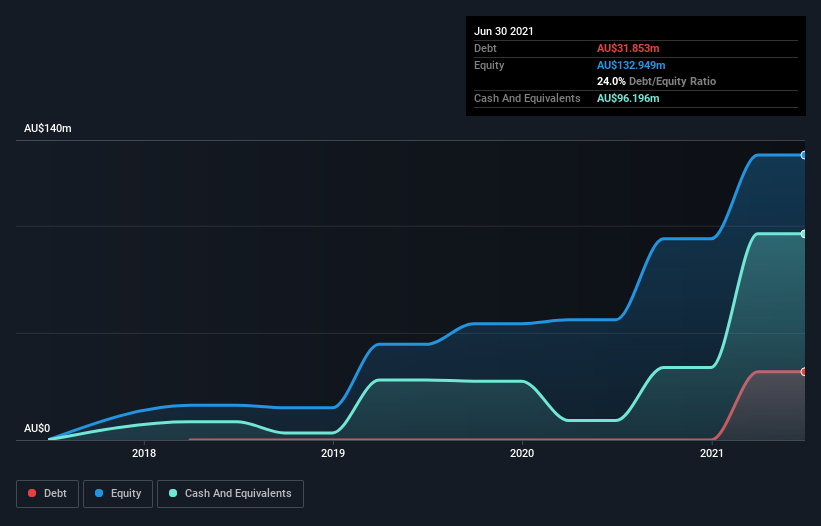Warren Buffett famously said, 'Volatility is far from synonymous with risk.' So it seems the smart money knows that debt - which is usually involved in bankruptcies - is a very important factor, when you assess how risky a company is. As with many other companies Galena Mining Limited (ASX:G1A) makes use of debt. But should shareholders be worried about its use of debt?
Why Does Debt Bring Risk?
Debt is a tool to help businesses grow, but if a business is incapable of paying off its lenders, then it exists at their mercy. In the worst case scenario, a company can go bankrupt if it cannot pay its creditors. However, a more usual (but still expensive) situation is where a company must dilute shareholders at a cheap share price simply to get debt under control. Of course, plenty of companies use debt to fund growth, without any negative consequences. When we examine debt levels, we first consider both cash and debt levels, together.
See our latest analysis for Galena Mining
How Much Debt Does Galena Mining Carry?
You can click the graphic below for the historical numbers, but it shows that as of June 2021 Galena Mining had AU$31.9m of debt, an increase on none, over one year. But on the other hand it also has AU$96.2m in cash, leading to a AU$64.3m net cash position.

How Strong Is Galena Mining's Balance Sheet?
The latest balance sheet data shows that Galena Mining had liabilities of AU$3.23m due within a year, and liabilities of AU$34.1m falling due after that. Offsetting these obligations, it had cash of AU$96.2m as well as receivables valued at AU$73.9k due within 12 months. So it can boast AU$58.9m more liquid assets than total liabilities.
This luscious liquidity implies that Galena Mining's balance sheet is sturdy like a giant sequoia tree. With this in mind one could posit that its balance sheet means the company is able to handle some adversity. Simply put, the fact that Galena Mining has more cash than debt is arguably a good indication that it can manage its debt safely. There's no doubt that we learn most about debt from the balance sheet. But you can't view debt in total isolation; since Galena Mining will need earnings to service that debt. So when considering debt, it's definitely worth looking at the earnings trend. Click here for an interactive snapshot.
Over 12 months, Galena Mining made a loss at the EBIT level, and saw its revenue drop to AU$516k, which is a fall of 3.6%. We would much prefer see growth.
So How Risky Is Galena Mining?
We have no doubt that loss making companies are, in general, riskier than profitable ones. And we do note that Galena Mining had an earnings before interest and tax (EBIT) loss, over the last year. Indeed, in that time it burnt through AU$24m of cash and made a loss of AU$3.6m. But at least it has AU$64.3m on the balance sheet to spend on growth, near-term. Even though its balance sheet seems sufficiently liquid, debt always makes us a little nervous if a company doesn't produce free cash flow regularly. The balance sheet is clearly the area to focus on when you are analysing debt. However, not all investment risk resides within the balance sheet - far from it. For instance, we've identified 5 warning signs for Galena Mining (2 are a bit concerning) you should be aware of.
If, after all that, you're more interested in a fast growing company with a rock-solid balance sheet, then check out our list of net cash growth stocks without delay.
New: Manage All Your Stock Portfolios in One Place
We've created the ultimate portfolio companion for stock investors, and it's free.
• Connect an unlimited number of Portfolios and see your total in one currency
• Be alerted to new Warning Signs or Risks via email or mobile
• Track the Fair Value of your stocks
This article by Simply Wall St is general in nature. We provide commentary based on historical data and analyst forecasts only using an unbiased methodology and our articles are not intended to be financial advice. It does not constitute a recommendation to buy or sell any stock, and does not take account of your objectives, or your financial situation. We aim to bring you long-term focused analysis driven by fundamental data. Note that our analysis may not factor in the latest price-sensitive company announcements or qualitative material. Simply Wall St has no position in any stocks mentioned.
Have feedback on this article? Concerned about the content? Get in touch with us directly. Alternatively, email editorial-team (at) simplywallst.com.
About ASX:G1A
Galena Mining
Galena Mining Limited engages in the acquisition and exploration of mineral projects in Australia.
Medium and slightly overvalued.
Similar Companies
Market Insights
Community Narratives




